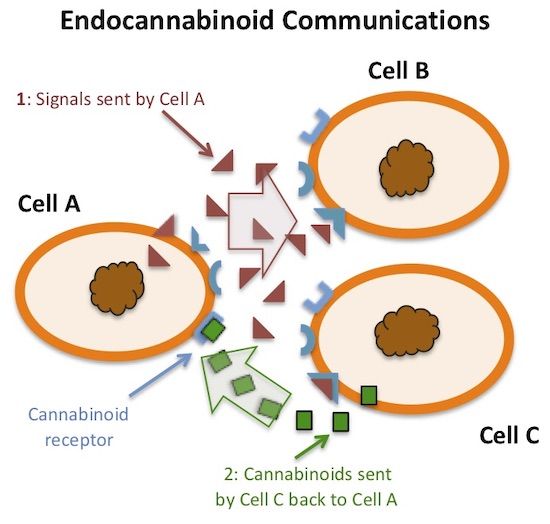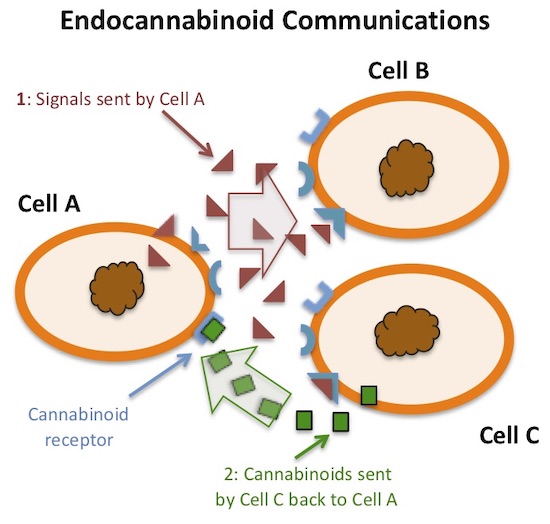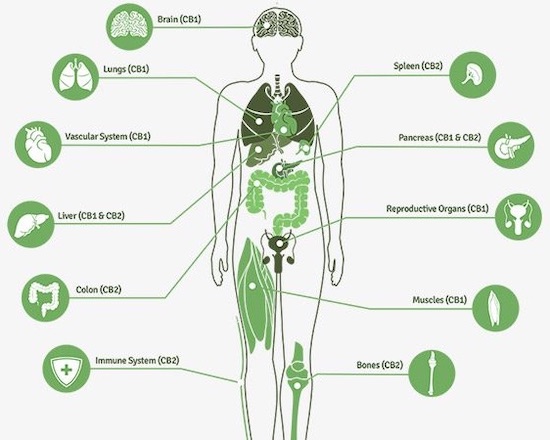Blogs
Overview of How the Endocannabinoid System Works
Ruth Fisher

So how does the Endocannabinoid System (ECS) in our bodies work? To understand this, we first have to understand some basics about cells and cell-to-cell communications.
Cells
A cell is the smallest unit of life. Cells are often called the "building blocks of life." Our bodies are comprised of trillions and trillions of different cells, approximately 32.7 trillion cells in all, of more than 200 different types.
Cells Cluster
Each cell has a particular function to perform. At the same time, however, cells cluster to form tissues, organs, and body systems, where they work together with other cells to serve larger functions (see Figure 1)
Figure 1: Cell Clusters

Cell-to-Cell Communication
Cells communicate with other cells —using electrical and chemical signals —to initiate and coordinate activity. The process of cell communication works a lot like how we communicate with one another. Our phones are signal receivers, or receptors. They receive signals (calls) from other people. However, only if we recognize the person calling us, will we accept the message and take action. Similarly, each chemical or electrical signal from sending cells is designed to fit into a specific type of receptor. Only if a signal fits into a corresponding receptor on the surface of a receiving cell – like a key unlocking a lock – will that cell take action.
Figure 2 illustrates this process of cell-to-cell communication. In Figure 2, Cell A releases chemical or electrical signals outside its cell membrane (the red triangles). The signals flow to other nearby or connected cells, Cell B and Cell C. If the receiving cells, Cell B and Cell C, contain receptors that can read Cell A’s signal, then those cells will take action. In the case depicted in Figure 2, Cell A’s signal activates a receptor on Cell B; in response, Cell B takes an action which includes sending a message onto other cells (the green diamonds).
Figure 2

We can make a couple of observations about these types of cell-to-cell communications:
- Cell-to-cell communications can lead to cascades of activity, as messages are passed from one cell to the next, generating activity all along the way.
- When the receptors for a particular signal are more numerous or widespread, then that signal can have larger or more widespread effects on the body.
Endocannabinoid System Components
Now that we have this information about cells in general, we can better understand the Endocannabinoid System (ECS). The ECS has three sets of components:
- Cannabinoid receptors: Receptors on cell membranes that are activated by cannabinoids
- Cannabinoids: The messengers, or neurotransmitters, that activate cannabinoid receptors
- Cannabinoid enzymes: The enzymes that break down, or inactivate, cannabinoids
Cannabinoids come from three different sources:
- Endocannabinoids: The cannabinoids made by our bodies
- Phytocannabinoids: are the cannabinoids that come from the cannabis plant
- Synthetic cannabinoids: Man-made chemicals
Cannabinoids from any of these three sources can activate cannabinoid receptors.
There are two important properties of the ECS: It uses retrograde signaling and its presence is widespread throughout the body.
Retrograde Signaling
Generally, cells send signals to receiving cells. Cells activated by the signal will, in turn, send their own signal on to other cells. It’s like a domino effect, where messages are sent down the line from one cell to the next.
The ECS is different. Suppose a cell receives and is activated by a message (Cell C in Figure 3), and that receiving cell responds to the received message by sending a cannabinoid. Rather than passing the cannabinoid onto the next cell, the receiving cell sends the cannabinoid back to the original sending cell (Cell A in Figure 3). Instead of a domino effect, the ECS creates a feedback loop. Feedback loops are used by the ECS to moderate activity by other cells, telling them either, “you’re not sending enough signals; send more,” or “you’re sending too many signals; cut back.” This is how the ECS maintains homeostasis in our body.
Figure 3

Widespread Presence
Another important property of the Endocannabinoid System is the fact that its signals and receptors are so widely distributed all over the body. This widespread distribution enables the ECS to have a widespread impact on our bodies.
There are two official types of cannabinoid receptors, CB1 and CB2. According to Wikipedia,
The CB1 receptor is expressed mainly in the brain (central nervous system), but also in the lungs, liver and kidneys. The CB2 receptor is expressed mainly in the immune system and in hematopoietic cells [the stem cells that give rise to other blood cells].
Another receptor, GPR55, is believed to be a third cannabinoid receptor. And at the same time, there are numerous other types of non-cannabinoid receptors that cannabinoids can activate.
Articles about the distribution of ECS receptors throughout our bodies generally provide one of two different types of descriptions. The Wikipedia statement above is typical of the first type of description about the distribution of ECS receptors throughout our bodies. The other type generally provides a diagram indicating the ECS affects all our body systems. Figure 4 is a typical diagram from this latter type of source.
Figure 4: Location of ECS Receptors

Source: https://www.kitbagshop.co.uk/new-products-from-cbd-relieve/
However, when I started digging deeper to better understand exactly how cannabis affects our bodies, I discovered that ECS receptors are much more widespread than suggested by most of the information out there. One source, 4 A Higher Good, does capture the pervasiveness of the ECS when it says, "Endocannabinoids and related CB1 and CB2 receptor sites are produced and found nearly everywhere in your body." In fact, in 7 Things You Probably Didn’t Know About The Endocannabinoid System, Tyler Strause claims,
The total number of endocannabinoid receptors in the body is believed to be greater than all other neuromodulatory receptors found in the body combined.
Since cannabinoids can affect our bodies wherever there are cannabinoid receptors, the widespread presence of cannabinoid receptors means cannabinoids (cannabis) can have widespread effects on us.

